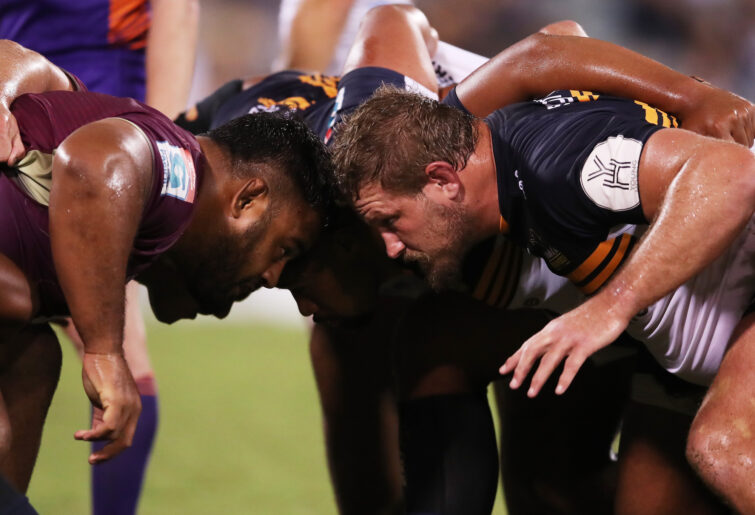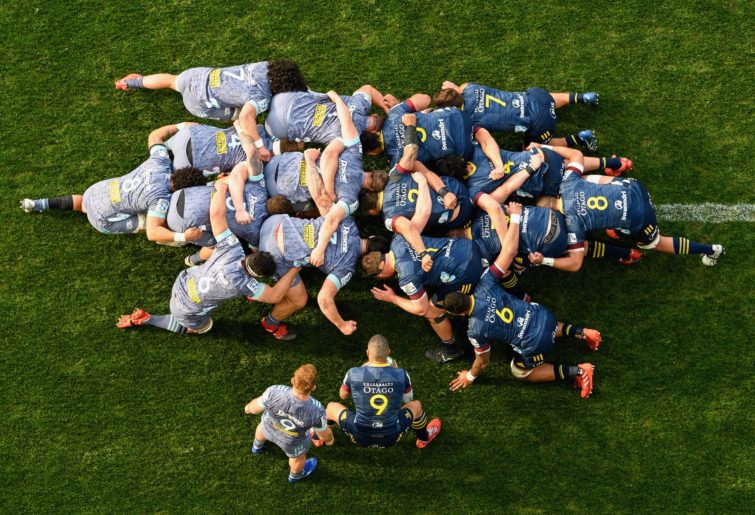
Rugby has always been a game of contrasts and tensions. Brute strength and forward power versus fleet-footed pace and light-fingered ball movement. North versus south. Crusty, old purist versus millennial instant-gratifier.
Everyone knows the cliché that rugby is a game for players of all shapes and sizes. That’s a concept that’s coming under increasing pressure. Ball-in-play and entertainment value are the new mantras, and for some who don’t truly understand rugby’s essence, bugger the consequences.
Rugby’s audience suffers through interminable scrum collapses and resets through too much dead time prior to scrums being set. Front rowers busy themselves asserting alpha-male dominance over their opponents, to hell with the watching audience. Referees guess at who might be responsible for bringing a scrum down. Welcome to the scrum, Ver. 2022.
According to a World Rugby definition, the scrum is “a means of restarting play after a stoppage which has been caused by a minor infringement of the laws (for example a forward pass, or knock-on)”.
Not known as practical jokers, World Rugby are surely pulling our legs? How about, “the scrum is an opportunity for players to clean turf from their sprigs, consult with water carriers, and gaze around the crowd, before coming together to try to force a penalty, so they can advance down the ground to a lineout, or kick for goal”?
In the recent Super Rugby Round 8 match between the Force and Rebels, of the 13 scrums in the match, six were reset, one of them three times. Six scrums resulted in penalties to the Rebels, and one a free kick. The Force received one penalty and one free kick.
Three times the Force cleared the ball from the scrum. Incredibly, only once in the match – in the 80th minute when they were running down the clock – did the Rebels use the ball from the back of the scrum.
That all adds up to not a lot of rugby. Finishing 22-21, the match was tense and tight, with the Rebels having to overcome the loss of a player to a red card. The chief reason the Rebels overcame that, and won the match, was because they won the scrum contest.
Think back to the 2019 World Cup final. England were effectively shut out of what most people thought beforehand, was Eddie Jones’ tour de force. South Africa made it a scrum contest, won it, and won the World Cup.

(Photo by Hannah Peters/Getty Images)
There’s rugby’s incongruity cropping up again. With few exceptions, you score points starting in the opposition half. Most tries in modern rugby originate from lineouts. One of the easiest and best ways to get a lineout in the attacking red zone is to win a scrum penalty.
The case for dominant scrums being disproportionately rewarded is made, and made strongly. A dominant lineout isn’t rewarded to anywhere near the same extent. You simply win more ball to play with. Which, if I’m not mistaken, was the original idea with the scrum, back in the days when the ball was rolled in somewhere near the middle, and both hookers struck for it.
Yet, tilt the balance too far the other way, and what do we get? Uncontested or de-powered scrums? Continual tap and go? The homogenisation of rugby players to the point where everyone looks and plays like a number six?
There are already three paths for people who wish to take that road: touch rugby, sevens rugby and rugby league.
While rugby undeniably has a problem with the scrum, it needs to find a different, more nuanced solution. Scrums give the game shape, contrast, ebb and flow. Scrums belong. But just like the raucous, handsy, over-lubricated uncle at a wedding, they need to know their proper place.
Looking for answers, I called in the experts. Nick Stiles is an ex-Wallabies prop and coach of the Reds, and is currently scrum coach and director of rugby for the Rebels.
Dan McKellar needs little introduction: ex-front rower, Super Rugby AU-winning coach with the Brumbies, and current Wallabies forwards coach.

(Photo by Kai Schwoerer/Getty Images)
And to provide a perspective from the other side of the whistle, I sought the thoughts of Australia’s referee’s boss, Mitch Chapman.
Common ground was found on a number of key points, including the acknowledgment that too much time is robbed from the game due to scrums needing to be reset.
Interestingly, time taken to form the scrum wasn’t viewed so critically. There are other ways where time can be more easily recovered.
For example, consider the way Matt Toomua sat on the ball to run the clock down for his allowed 90 seconds, before kicking a conversion in the Rebels’ recent win against the Drua. There’s a minute of rugby easily clawed back right there.
The theatre of a lineout now involves a team huddle to pre-call, a messenger dispatched to the hooker to advise of the call, the hooker stepping off the mark so as to aim up more down his side, and the referee’s obligatory step-in to remind players to keep a gap. All of that nonsense can be run out of the game faster than it was allowed to creep in.
But the quest to speed the game up has limits. Prop forwards are today’s super-athletes, asked to lift and block at lineout and kick-off, hit every ruck like they mean it, run the ball up with purpose, and distribute at first receiver.
That’s before they take their place in the defensive line: down, up, back and forward on high rotation, like SAS recruits in a training drill, expected to make 15 tackles per match while doing so.
All energy-sapping stuff, anaerobic and aerobic. How can they be expected to not only push like trojans at the scrum, but even have the capacity to hold the scrum up, if there isn’t space somewhere, for them to catch a breath?
Despite this, and with all three emphasising the safety elements, Stiles has a belief that we can provide more rugby.
“We shouldn’t be afraid of creating more fatigue, and what that might do for the game,” he says.
“I think we can still get players set quicker, and get the ball in faster.”
And out. Chapman explains how referees have focused on getting teams to play the ball away from the scrum if it is readily available, even after a collapse, and it is evident that this is happening more in general, but more specifically, under some referees more than others.

(Photo by Matt King/Getty Images)
Angus Gardner for example, in the second Reds versus Brumbies match this season, oversaw 15 positive outcomes from 21 scrum feeds.
McKellar believes that too many referees let things play out for too long before awarding a penalty.
“In some cases, there are actions that should be penalised even before the scrum is set,” he explains.
“Yet because referees might be hoping for a good outcome, they proceed with the scrum, only for it to inevitably collapse and be reset again. In many cases, decisions need to be made earlier.”
How penalties are determined remain a bone of contention for fans, coaches and players, all feeling like they participants in a lottery.
Chapman outlines how Wallabies scrum coach Petrus du Plessis is now a constant fixture in the referee’s coaching and weekly review process, helping individual referees identify rights and wrongs from the weekend’s performance.
But even if better education results in more technically correct penalties being awarded, what of the conundrum the game faces, where scrums are increasingly being used as a means to win a penalty in the first place?
“There’s a definite contrast between the way the game is played in New Zealand, and increasingly in the UK, compared to in Australia,” Stiles says.
“They are more ‘ball-in, ball-out’ whereas we are more fixated on the scrum as a contest.”
It’s an irony not lost on McKellar.
“It’s not that long ago that the Wallabies’ scrum was a laughing stock on the world stage. We’ve done really well to recover that to a point where we have as good a scrum as any nation, but the downside of that, is that it’s not necessarily what the game needs, with respect to entertainment value.”
How fair is it then to place the onus for that, back on the coaches?
“I think we’re all conscious of trying to play the game the right way, to entertain fans and so on, but we’re also charged with winning,” McKellar says.
“If the Reds have Taniela Tupou, now acknowledged as one of the most powerful scrummagers in world rugby, you can hardly expect Brad (Thorn) not to have him at the centre of his game plan.

(Photo by Mark Kolbe/Getty Images)
“It’s just the same as us (the Brumbies) and the lineout maul. A try is worth five points no matter how you score it. All coaches play to their strengths.”
Stiles concurs.
“The scrum is the only true one versus one contest in the game, so of course coaches and players are going to focus there. Weaknesses are going to be probed. Nobody says when a runner targets the weak shoulder of a centre, that’s negative play or it’s ruining the game.”
Chapman heads down the rabbit hole that is advantage, and how that introduces even more frustration.
“Rather than immediately blow for a scrum penalty, referees are inclined to want to see the ball used. But with kickers able to peel off 40 and 50 metres to touch, to a lineout their feed, it’s seldom that sufficient advantage accrues.
“So, the issue then becomes one of dead time, where rugby is being played, but which often turns out to be meaningless.”
Indeed. What then, are the alternatives? Fewer reasons for penalties at scrum?
This would bring us closer to the lineout situation, where a dominant side might enjoy the benefit of winning the ball on the front foot, or forcing ugly, unusable ball on to the weaker side, but not necessarily an easy piggy-back down the field.
Against that, this would potentially remove the incentive for the weaker scrum to actually measure up. If the worst that can happen is to concede scrums or free kicks – not long-arm penalties or yellow cards – that’s a dice they’ll roll all day long.
On a recent Roar Rugby Podcast, renowned Test referee Jonathan Kaplan discussed some of the law variations being trialled in the USA’s Major League Rugby, including allowing only one reset (the referee thus being mandated to award a free kick or penalty at the second failed scrum), no reset option from a free kick, and the defensive halfback not being permitted to move beyond the mid-point of the scrum.

(Photo By Brendan Moran/Sportsfile via Getty Images)
While the latter two are common sense, there’s an overall feel of solving the issue of fixing scrums simply by not having them.
Another option is to ensure better ball-in-play ratios by turning the match clock off while scrums are being set and reset.
One scrum in the second half of this year’s Six Nations match between France and England took a tick under three and a half minutes from go to whoa. That’s over four per cent of the match for a single scrum.
How does that represent value for fans, or even satisfaction for purists?
Also, anyone who saw France run the clock down at the end of the recent Six Nations match against Ireland, or who witnessed South Africa do the same thing to Wales in the 2019 World Cup semi-final, understands how scrums can be used for shady purposes.
But in a wider sense, even with the incentive to waste time taken away, and even if fans aren’t robbed of game time by stopping the clock, if scrums are collapsing for a reason, the tedium of the reset, and time wafting away into thin air, would still be present.
Further still, broadcasters don’t like the idea of open-ended matches playing havoc with their scheduling.
McKellar views that as a potential opportunity for rugby.
“It’s a chance for a paradigm shift. Look at the NFL. Every time the clock stops is an opportunity for expert analysis, slickly presented, all designed to educate and entertain the viewer. They don’t see it as a problem, in fact it adds to the experience.”
It’s entirely possible. Allow say, a minute, time off the match clock, for a reset, and train the TV cameras elsewhere while that 60-second scrum clock is ticking; somewhere productive, not at players standing around doing nothing.
At the heart of any solution or potential change with respect to scrums, must be the safety of players. Rugby in the 1970s experienced a glut of players all around the globe suffering spinal cord injuries, resulting in paraplegia, quadriplegia and death.

(Photo by Kai Schwoerer/Getty Images)
Law variations were trialled in the UK and Australia in 1985, which were aimed at reducing the momentum of forward packs when engaging, and by 1990 these measures were in practice worldwide, at all levels of the game.
Almost immediately, Australia experienced significant reductions in the number of spinal cord injuries, and while New Zealand and South Africa were slower to achieve positive outcomes, these eventually came.
With approximately 150,000 registered rugby players, New Zealand now experiences on average one or two cases per year, almost all from tackles. In the 1970s and early 1980s, it felt like Christchurch’s Burwood Spinal Unit was receiving a case every weekend, mostly from scrums.
Having fixed such an important issue, there is no way rugby is going back to those dark days, all for the sake of expediency and/or chasing new viewers. Whatever the solution might be, there must be no players sacrificed in its pursuit.
Rugby has changed, in large part because the players have changed. The strength and conditioning genie is out of the bottle. Today’s players are bigger and stronger than ever, and getting stronger still.
What is the point if they don’t use that strength to assert themselves?
Short of whacking a syringe into the nut sack of every front-row forward and removing a vial of testosterone, or asking them all to sign a pledge that they won’t selfishly wrestle the sport into oblivion, what is there to be done?
Anyone who watches rugby knows there are days, right from the first scrum, when everything feels right. The ball goes in, the scrum is rock solid, the ball is cleared, it’s game on.
Conversely, on the days when there are old scores to be settled, or the referee doesn’t seem to have rapport with the players, and the first scrum collapses, hearts sink and you just know it’s going to one of those matches.
Perhaps this is a problem without a solution?
As technical as the modern scrum is, there is a randomness to outcomes that are a function of the sheer number of variables that can’t realistically be controlled.
As soon as 1800 kilograms of writhing muscle starts tipping in the wrong direction, there isn’t an invention known to man that’s going to keep it upright.
Rugby is, after all, a game of many imperfections. Is it the case that unrealistic expectation, and the elusive, futile search for some undefined perfection, is the real problem?